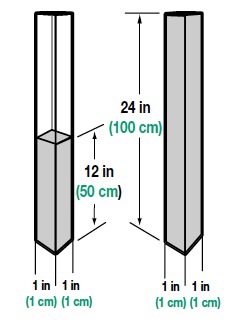
Periodically I will be doing posts on understanding how water behaves in your sprinkler system and hopefully this will help you understand what is going on with your sprinkler system when there are problems. In this post I will begin with understanding the basics of hydraulics.
Hydraulics is simply the study of fluid behavior in motion and at rest. In our case, this fluid is water.
For practical purposes, water is not compressible, and since it is not compressible it must be pressurized for residential and commercial use. This can be done by pumping the water or by using the weight of the water itself. Proper design in a sprinkler system with sound hydraulics is critical. A well designed will give years of trouble free service. Controlling water flow velocity and holding it to proper parameters reduces wear in the sprinkler system and lengthens the life of the sprinkler system. Poor design will result in stress on all the parts in the system and potentially broken pipes and flood damage.
Water is heavy. One gallon of water weighs 8.3 pounds. One cubic foot of water weighs 62 pounds! Water also responds to gravity and seeks its own lowest level. Water exerts pressure which is defined as the force of water over a given area. This pressure is measured in pounds per square inch (lb/in²) and/or feet of head (ftH₂O). In the metric system water is measured in kilograms per square centimeter (kg/cm²) and/or meters (m H₂O). A column of water like the illustration above that is 1 foot high with an area of 1 square inch will weigh 0.433 pounds. Therefore, our column of water on the left of the illustration will exert a pressure of 0.433 lb/in² at its base due to the weight of the water. If we double the height of the water like the illustration on the right, we double the pressure. 0.433 x 2 feet of height = .866psi. The relationship between pressure and elevation is known as “feet of head” (meters of head). For example, 200 feet of water height x .433 produces 86.6 psi at its base. In meters, 100 meters of water x 0,1 kg/cm² = 10kg/.cm² or 10 bar of pressure at its base.
Review of pressure equivalents:
- 1 foot head = 0.433 lb/in²
- 1 psi = 2.31 feet of head
- 1 meter head = 0.1 kg/cm²
- 1 kg/cm² = 10 meters of head
- For example: 100 psi x 2.31 = 231 feet of head.
- For example: 1 kg/cm² = 10 meters of water = 1 bar, or 10 kg/cm² = 100 meters of head.
Hydrostatic refers to the properties of water at rest, and hydrodynamic refers the the properties of water in motion. We will be dealing mainly with hydrodynamic properties of water in future posts, because we want water coming out of our sprinkler heads and making our yards beautiful.
